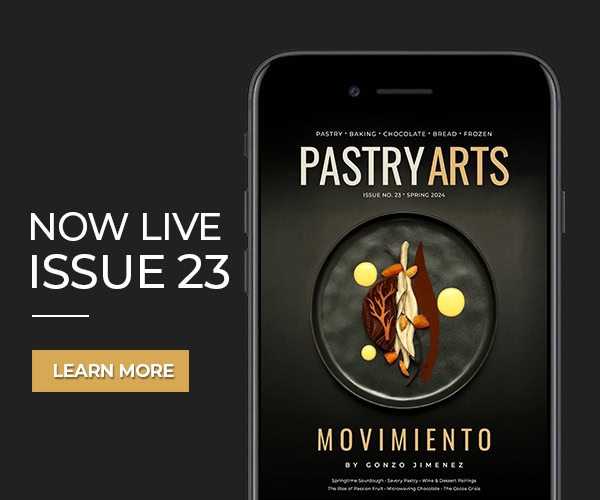“The discovery of a new dish does more for human happiness than the discovery of a new star.”
–Jean Anthelme Brillat-Savarin, La Physiologie du Gout
I’m often asked about my approach to creativity and cooking, but it is a difficult question to answer. Every pastry chef has their own method toward building a dish that suits their own needs and sensibilities, and what may work for one may not work for others. I do think, however, that creativity in food is less about divine inspiration, and more a deliberative pursuit – a muscle, perhaps – that requires regular exercise. Personal expression in a plated dessert is the sum of all that we see and taste, filtered and processed through our own unique perspective and aesthetics, and further enhanced by our accumulated set of technical skills.
I joke, sometimes, that when I was a much younger chef I could easily sit down and write a five- or six- item dessert menu in a matter of minutes, because at the time I only knew five or six things. With all the experience and knowledge I’ve gained as a pastry chef since, that task now can be far more difficult. I have a wider range of techniques to employ, a deeper catalog of flavors and ingredients to draw from, and many hundreds, if not thousands, of recipes to reference. Chefs across that spectrum – from novice to well-seasoned – can benefit from internal editing and a framework to help guide the creative process. My own processes have evolved over time, to the point where many of my decisions are made subconsciously. I didn’t always analyze how or why I came to one conclusion or another. Several years ago, I sought to quantify the key elements that go into building a dessert, to better understand for myself – and explain to others – a basic creative framework.
As I began to grasp my role as mentor to the cooks who worked with me, I also understood the value of sharing the task of menu development with my team. One purpose was simply to check my own ego, but I also realized that most pastry cooks working their way up the ladder don’t get much experience in the creative process until they eventually take on the title of ‘chef.’ I quickly learned, however, that I needed to build structure to the crowd sourcing of ideas, or else I become deluged with half-formed thoughts throughout the course of any given day. In exchange for time and resources to work out their ideas, I simply asked my cooks to present them in written form with some base recipes to show they had put in a minimum of thought and research. From there, I had them apply the first test toward refining their effort – ten simple concepts to make sure their efforts were heading in the right direction:
- Flavor
- Texture
- Temperature
- Balance
- Portion and Proportion
- Focus
- Presentation
- Refinement
- Innovation
- Simplicity/Complexity
Flavor is, of course, first and foremost, as are interesting (and correct) textures. Plated desserts served in a restaurant setting offer a unique opportunity to play with temperature – hot, cold, frozen, and even room temperature. Creating contrasting or complementary balance of all these elements is also key – sweet and acid, crunchy and creamy, warm and cool. But then so is appropriate portion size and proportion of components; a compelling idea is to ‘flip’ the ratios of an element to see how the focus of a dish might shift.
With focus in mind, I find each dish should have a starring role – one central flavor or ingredient, or a combination of two or three ingredients. This could be expressed in subtle or overt ways. One flavor can be expressed in several forms, or simply elevated by complementary flavors. When it comes to presentation, most chefs will say that it is secondary to flavor, texture, balance, and the like, which I agree with, but as pastry chefs we can manipulate our ingredients to such a degree that the final form of an ingredient is closely linked to flavor and texture from the outset of development.
In thinking about refinement, I might ask myself, “If the texture of a mousse is supposed to be creamy, how do I make it creamier?’ or ‘If a garnish should be thin and crunchy, how do I make it thinner and crunchier?” How do we preserve, concentrate, or otherwise a improve an ingredient’s flavor? We achieve this continual pursuit toward refinement by simply honing our technical skill, or breaking down our recipes to better understand the cause-and-effect of its method and ingredients. And that’s where innovation comes in. It’s not a necessary requirement of a dessert, but even on a subtle level, I like a new dish to in some way incorporate something new, even if its just a new flavor or technique for myself and my team.
And finally, I challenge young cooks to consider simplicity and complexity – both valid approaches to developing a dish. As a diner, I’ve enjoyed equally desserts that display a riotous (but cohesive) cacophony of components and those that are minimalist in design, to the point of austerity. I might push myself further to assess how simplicity can be complex, and vice-versa, how complexity creates an effect that is greater than the sum of its many parts. At some point during the construction of a dessert, I do like to step back and edit the results, to pare away anything that is not essential to the original idea.
I find these guidelines helpful in reigning in the creative process, and from there, I might introduce a number of more thoughtful concepts – appropriate seasonality, adding elements of action or surprise, considering a desserts’ inner ‘architecture’, or unconventional ways of devising flavor combinations. Below, I outline how some of these ideas have helped me shape some of my own plated desserts over the years. 
Passion Fruit Verrine
With passion fruit as a focal point, this dish is largely an exercise in presenting that flavor in several ways – a cream, sorbet, sponge cake, fluid gel, and pearls, their varying degrees of tartness balanced by mascarpone and milk chocolate components. There is a lot happening texturally, and by building the dessert into a verrine, an element of surprise is added. The idea of cake as a garnish comes from the concept of ‘flipping’ components; one could easily flip the elements back into, say, an entremets-style cake with similar, but different, effect.
‘Flowers’
In addition to balance of flavor, texture, and temperature, the core concept of this dessert lies in how I assembled its flavors – coconut, mango, rose, and pistachio. Inspired by typical flavors of Indian sweets and the notion that “what grows together, goes together.” The presentation is guided by the simple design elements of slight asymmetry and odd numbers of components.
‘Mille Feuille’
Milk chocolate plays a starring role in this dessert, but I’m also thinking about architecture and the effect of the layering components not just in terms of presentation, but also with how it is eaten. Refinement comes into play when considering the ultra-thin rectangles of tempered chocolate; if too thick, the textures are out of balance and the dish becomes difficult to eat.
 Passion Fruit Verrine by Michael Laiskonis
Passion Fruit Verrine by Michael Laiskonis
Creative Director, Institute of Culinary Education, New York, NY
Yield: approximately 8 servings as a plated dessert
Passion Fruit Curd
- 100 g whole eggs
- 150 g granulated sugar
- 85 g Boiron Passion Fruit Purée
- ½ sheet gelatin, bloomed
- 85 g unsalted butter
- In a saucepan, whisk together the eggs and sugar, and then whisk in the puré Cook over medium heat, stirring constantly (as it will easily scorch on the bottom), until the mixture reaches 185˚F (85˚C).
- Remove from heat and add the gelatin. Emulsify the butter into the base in small amounts with an immersion blender.
- Deposit approximately 50g into each ‘verrine’ glass and freeze.
Mascarpone Cream
- 130 g whole milk
- 50 g granulated sugar
- 1 sheet gelatin, bloomed
- 135 g mascarpone cheese
- In a saucepan, combine the milk and sugar, gently warming over medium heat.
- Remove from the heat and add the gelatin, stirring to dissolve. Temper into the mascarpone and emulsify with an immersion blender.
- Deposit approximately 40g as a second layer into each ‘verrine’ glass and freeze.
Milk Chocolate Cream
- 130 g whole milk
- 120 g heavy cream (36% fat)
- 15 g granulated sugar
- 40 g egg yolks
- 1 sheet gelatin, bloomed
- 175 g milk chocolate
- In a saucepan, combine the milk and cream and gently warm over medium heat. In a small bowl, whisk together the sugar and egg yolks.
- Temper the hot milk mixture into the egg yolks, return to the saucepan, and heat to 185˚F (85˚C), stirring constantly.
- Remove from the heat and add the gelatin, stirring to dissolve. Incorporate into the milk chocolate and emulsify with an immersion blender.
- Deposit approximately 60g as a third layer into each ‘verrine’ glass and chill to set.
Passion Fruit Sorbet
- 260 g granulated sugar, divided
- 5 g sorbet stabilizer
- 420 g water
- 65 g glucose powder
- 25 g invert sugar
- 500 g Boiron Passion Fruit Purée
- Combine 20 g of the sugar with the stabilizer. Reserve.
- In a saucepan, heat the water to 120˚F (50°C). Whisk in the stabilizer mixture, followed by the remaining 240 g sugar, glucose powder, and the invert sugar. Bring just to a boil and remove from heat.
- Chill and allow the syrup to mature for at least 4 hours.
- Combine the purée and syrup and process in batch freezer; extract the mix at 23˚F ( -5˚C). Alternatively, transfer to PacoJet canisters and freeze; process as needed. Continue to harden the sorbet at 0˚F ( -18˚C), as necessary.
Passion Fruit Fluid Gel
- 150 g Boiron Passion Fruit Purée
- 150 g granulated sugar
- 150 g water
- 4 g agar agar
- Combine the purée and sugar; gently warm to 95˚F (35˚C). Reserve.
- Combine the water and agar in a small saucepan and bring to a boil over medium heat; reduce heat and hold a simmer for 30 seconds. Remove from heat and stir in the passion fruit mixture. Allow to cool and set to firm gel at room temperature.
- Break up the gel and place into a variable-speed blender and process until smooth.
- Transfer to a squeeze bottle and reserve.
Passion Fruit Pearls
- 50 g Boiron Passion Fruit Purée
- 75 g Boiron Mango Purée
- 25 g granulated sugar
- 75 g water
- 1.5 g agar agar
- 0.2 g locust bean gum
- Grapeseed oil (40˚F/5˚C), as needed
- Combine the purées and sugar; gently warm to 95˚F (35˚C). Reserve.
- Combine the water, agar, and locust bean gum in a small saucepan and bring to a boil over medium heat; reduce heat and hold a simmer for 30 seconds. Remove from heat and stir in the passion fruit mixture.
- Transfer to a squeeze bottle and immediately deposit droplets into the cold oil. Chill and allow 5-10 minutes to set; drain well and reserve.
Passion Fruit Chiffon Sponge
- 105 g cake flour
- 5 g baking powder
- 2 g salt
- 50 g egg yolks
- 45 g water
- 40 g Boiron Passion Fruit Purée
- 50 g vegetable oil
- 125 g granulated sugar, divided
- 120 g egg whites
- Combine and sift together the cake flour, baking powder and salt. Reserve.
- Whisk together the egg yolks, water, purée, oil and 100 g of the sugar. Gently incorporate the sifted dry mixture into the egg yolk mixture.
- Prepare a simple meringue with the egg whites and the remaining 25 g sugar. Fold into the base mixture.
- Transfer to a parchment-lined quarter-sheet pan and bake in a convection oven at 320˚F (160˚C) until lightly browned and thoroughly baked, approximately 15-20 minutes.
- Allow to cool completely. Cut into 0.4ʺ (1cm) cubes and reserve in a sealed container.
Passion Fruit Marshmallow
- 8.5 g gelatin powder (225-bloom)
- 50 g water, cold
- 95 g Glucose syrup, divided
- 60 g Boiron Passion Fruit Purée, divided
- 30 g water
- 135 g granulated sugar
- Dextrose, as needed
- In the bowl of a stand mixer, hydrate the gelatin in the water. Add 45 g of the glucose syrup and 10 g of the passion fruit purée and reserve.
- Combine the water, the remaining 50 g of purée, the sugar, and the remaining 50 g of glucose in a saucepan and bring to a boil over medium heat. Continue to cook to a final temperature of 230˚F (110˚C).
- Remove from the heat and pour the cooked syrup over the gelatin mixture and whip on high speed for 7-8 minutes, or until the mixture is light and fluffy and has cooled to approximately 75˚F (24°C).
- Transfer the mixture into prepared frames and allow to set for several hours.
- Cut the marshmallow into 5mm cubes and coat with dextrose powder; reserve in a sealed container.
Assembly
- White chocolate décor
- Lime zest
- Gold leaf
- Assemble the verrines by arranging pieces of the chiffon sponge, marshmallow, pearls, and the fluid gel. Top with a small quenelle of the sorbet, followed by the white chocolate décor, more fluid gel, lime zest, and gold leaf.
(This article appeared in the Spring 2023 issue of Pastry Arts Magazine)






You must be logged in to post a comment.